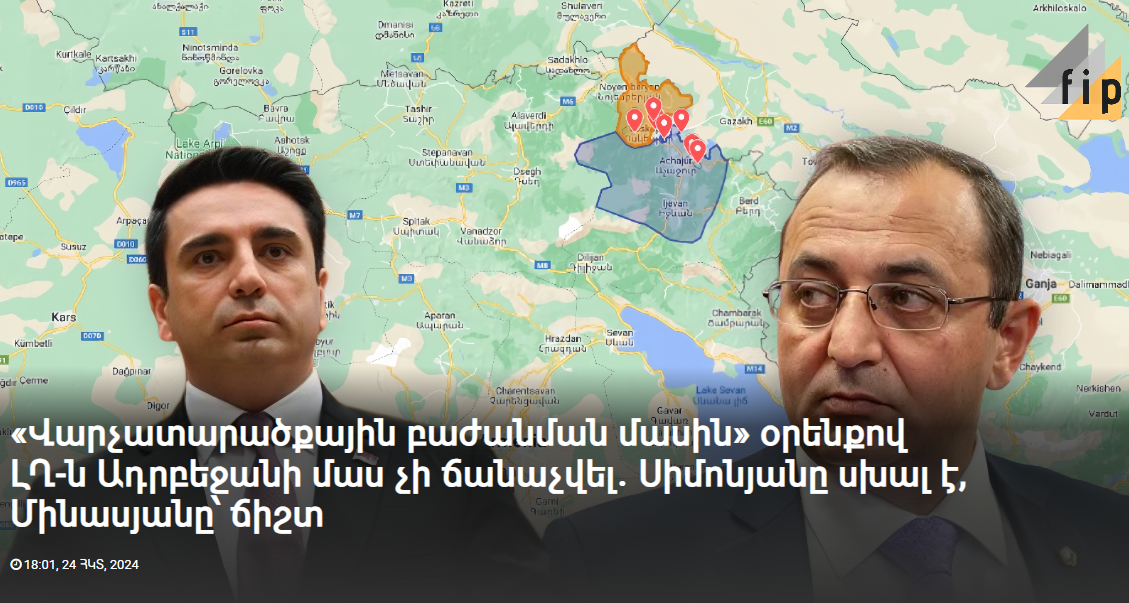National Assembly Speaker Alen Simonyan claimed at the October 22 session of parliament that former authorities recognized Artsakh as part of Azerbaijan through the law titled “On Administrative Territorial Division,” which was adopted in 2010.
In response to a question from ARF deputy Gegham Manukyan of the Hayastan faction, Simonyan remarked, “When you discussed and adopted the ‘Territorial Division’ law, your party, the ARF, personally acknowledged that it was Azerbaijan. What were you doing then?”
Another ARF deputy from the same faction, Artsvik Minasyan, responded, accusing Simonyan of spreading falsehoods by claiming that the ARF recognized Artsakh as part of Azerbaijan, referencing the “Law on Administrative Territorial Division.”
In response, Simonyan accused Minasyan of lying and reiterated his claim, asserting that ARF deputies once voted in favor of a law that mentioned Azerbaijan as the boundary across the border.
The Fact Investigation Platform has repeatedly addressed Simonyan’s and Civil Contract Party officials’ claims, demonstrating that they are false and do not align with reality.
The Prime Minister First Spread the False Claim Discussions surrounding the “Territorial Division” law resurfaced after the 44-day war of 2020, when, in December, Prime Minister Nikol Pashinyan cited the law to justify handing over certain Armenian settlements and roads to Azerbaijani control. In a Facebook post, Pashinyan referenced the border lines of the Shurnukh and Vorotan villages in the Syunik marz, later mentioning the border lines of Sotk village in the Gegharkunik marz.
Pashinyan reiterated this claim on Public TV, stating, “In 2010, the Law ‘On Administrative Territorial Division of RA’ was adopted, which specifies that the Vorotan village in Syunik marz borders Azerbaijan. If they recognized that the territory of Azerbaijan existed within Armenia’s borders, how can they now say Azerbaijani representatives entered Armenian territory?”
Both Pashinyan and other CP officials have since repeated this claim numerous times.
When Was the Law Passed and What Does It Entail? The “Law on Administrative Territorial Division” was initially adopted on November 7, 1995, taking effect on December 15 that same year. Since then, the law has been amended multiple times.
The term “Azerbaijan” first appeared in the law in October 2009, when amendments included references to Vayots Dzor communities. For instance, the law stated that the city of Jermuk borders Azerbaijan to the northeast, though in reality, this area corresponded to the Karvachar region of Artsakh.
Although the law references coordinates in some sections, such as “From the nodal border point ‘C’ of the division of Jermuk city, Gndevaz rural communities, and Syunik marz…,” these coordinates were likely based on a map, yet no such map is publicly accessible.
Notably, the law lacks precise coordinates to define the Azerbaijani border in detail for specific settlements. It merely states that the boundary aligns with the Azerbaijani state border.
When Pashinyan and his associates refer to 2010, they likely mean an amendment made to the “Administrative Territorial Division” law that year, which delineated the boundaries of Syunik marz communities. For example, these amendments specified that the Shurnukh village community bordered Azerbaijan along certain sections. However, the amendment still did not provide precise coordinates for where Azerbaijani borders begin or end.
External Borders Are Not Defined by Domestic Law Fip.am consulted experts to understand whether domestic law can establish external borders.
According to cartographer Anushavan Barseghyan, the “On Administrative Territorial Division” law was based on a secret Soviet map. Barseghyan noted that on maps he reviewed, for example, Shurnukh village was entirely within Armenian territory.
“The law was based on Soviet maps, using terrain markers such as elevation points, to describe community borders. However, it does not define the state border,” Barseghyan explained.
Levon Gevorgyan, a member of the Professional Commission for Constitutional Reforms, further emphasized that the “On Administrative Territorial Division” law addresses only internal state divisions for local governance purposes, not international borders.
“Setting the border is beyond the National Assembly’s authority. Armenia’s border is determined by international agreements and a clearly established procedure. Political agreements on borders also require review by the Constitutional Court,” Gevorgyan told Fip.am.
Gevorgyan added that no international agreement has clarified the Armenia-Azerbaijan border, whether through interstate commissions or international court rulings.
Even if it were possible to establish an interstate border under the “On Administrative Territorial Division” law, Nagorno Karabakh has never shared a border with Armenia. Furthermore, Armenian authorities, at least in statements to international partners, have not contested that adjacent regions of Nagorno Karabakh belong to Azerbaijan.
Thus, Simonyan’s claim that Armenia recognized Artsakh as part of Azerbaijan in 2010 through the “Territorial Division” law remains inaccurate.
— Nane Manasyan (fip.am)
This article was translated by Oragark from its original in Armenian on fip.am




